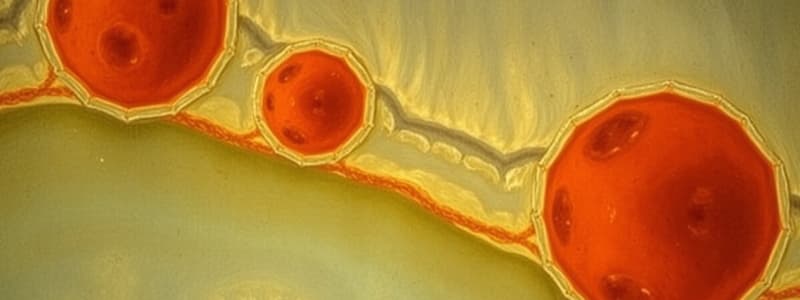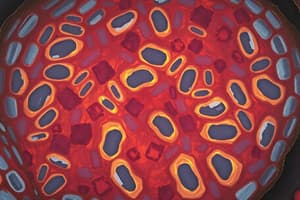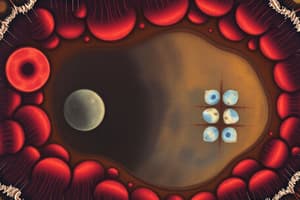Podcast
Questions and Answers
What is the role of the different concentrations of sodium and potassium in cells?
What is the role of the different concentrations of sodium and potassium in cells?
- They help in cellular respiration.
- They maintain normal cell volume and generate electrical signals. (correct)
- They assist in protein synthesis.
- They activate the immune response.
How do secondary active transport mechanisms utilize ATP?
How do secondary active transport mechanisms utilize ATP?
- They do not use ATP at all.
- They bypass ATP through passive diffusion.
- They consume ATP indirectly by using ionic gradients. (correct)
- They hydrolyze ATP directly.
Which type of transport moves two substances in the same direction?
Which type of transport moves two substances in the same direction?
- Exchangers
- Antiporters
- Symporters (correct)
- Transcytosis
What characterizes receptor-mediated endocytosis?
What characterizes receptor-mediated endocytosis?
What is the role of pseudopods in phagocytosis?
What is the role of pseudopods in phagocytosis?
What is the function of macrophages in the immune system?
What is the function of macrophages in the immune system?
What happens during the fusion step of receptor-mediated endocytosis?
What happens during the fusion step of receptor-mediated endocytosis?
What distinguishes neutrophils among phagocytes?
What distinguishes neutrophils among phagocytes?
What occurs after a phagosome fuses with lysosomes?
What occurs after a phagosome fuses with lysosomes?
What is an isotonic solution?
What is an isotonic solution?
What happens to red blood cells (RBCs) in a hypotonic solution?
What happens to red blood cells (RBCs) in a hypotonic solution?
What is a residual body?
What is a residual body?
What is the effect of a hypertonic solution on RBCs?
What is the effect of a hypertonic solution on RBCs?
During pinocytosis, what happens to extracellular fluid?
During pinocytosis, what happens to extracellular fluid?
What is hemolysis?
What is hemolysis?
What type of cells primarily perform pinocytosis?
What type of cells primarily perform pinocytosis?
What is the main purpose of exocytosis?
What is the main purpose of exocytosis?
What does dialysis involve?
What does dialysis involve?
What do secretory vesicles do during exocytosis?
What do secretory vesicles do during exocytosis?
In what type of solution does the concentration of solutes exceed that of the cytosol in RBCs?
In what type of solution does the concentration of solutes exceed that of the cytosol in RBCs?
What characterizes a semipermeable membrane used in dialysis?
What characterizes a semipermeable membrane used in dialysis?
Which of the following best describes transcytosis?
Which of the following best describes transcytosis?
What is one role of nerve cells in exocytosis?
What is one role of nerve cells in exocytosis?
Which of the following solutions is isotonic with respect to red blood cells?
Which of the following solutions is isotonic with respect to red blood cells?
What process occurs most frequently across the endothelial cells that line blood vessels?
What process occurs most frequently across the endothelial cells that line blood vessels?
In osmosis, what direction do water molecules move?
In osmosis, what direction do water molecules move?
Which mechanism allows water to pass through a plasma membrane during osmosis?
Which mechanism allows water to pass through a plasma membrane during osmosis?
What happens to the volume of water in the area of higher concentration during osmosis?
What happens to the volume of water in the area of higher concentration during osmosis?
What type of membrane is necessary for osmosis to occur?
What type of membrane is necessary for osmosis to occur?
What do isosmotic solutions have in common?
What do isosmotic solutions have in common?
What must be applied to stop fluid movement across a semipermeable membrane?
What must be applied to stop fluid movement across a semipermeable membrane?
How do water molecules move through a plasma membrane during osmosis?
How do water molecules move through a plasma membrane during osmosis?
What is the function of the plasma membrane?
What is the function of the plasma membrane?
Which organelle is known as the control center of the cell?
Which organelle is known as the control center of the cell?
What is the primary function of ribosomes?
What is the primary function of ribosomes?
What type of endoplasmic reticulum is responsible for synthesizing lipids?
What type of endoplasmic reticulum is responsible for synthesizing lipids?
What do lysosomes contain that aid in their function?
What do lysosomes contain that aid in their function?
What role does the Golgi apparatus play in the cell?
What role does the Golgi apparatus play in the cell?
Which structure is primarily responsible for ATP synthesis?
Which structure is primarily responsible for ATP synthesis?
What is the function of centrioles during cell division?
What is the function of centrioles during cell division?
Which cellular structure aids in moving materials over the surface of cells?
Which cellular structure aids in moving materials over the surface of cells?
What is the main function of microvilli?
What is the main function of microvilli?
What is the function of peroxisomes?
What is the function of peroxisomes?
What is the Fluid Mosaic Model describing?
What is the Fluid Mosaic Model describing?
How are the structures of cilia and flagella similar?
How are the structures of cilia and flagella similar?
What is a primary role of proteasomes in the cell?
What is a primary role of proteasomes in the cell?
Flashcards are hidden until you start studying
Study Notes
Cell Structure and Function
- Plasma Membrane: Lipid bilayer of phospholipids and cholesterol, controls substance movement, enables intercellular communication, and contains recognition markers.
- Nucleus: Double membrane with pores; houses DNA regulating protein synthesis and cell functions, features nucleoli for ribosomal RNA production.
Cytoplasmic Organelles
- Ribosomes: Composed of ribosomal RNA and proteins; sites of protein synthesis found as free ribosomes or attached to rough endoplasmic reticulum.
- Rough Endoplasmic Reticulum (RER): Membranous tubules with attached ribosomes; synthesizes and transports proteins to the Golgi apparatus.
- Smooth Endoplasmic Reticulum (SER): Membranous tubules without attached ribosomes; manufactures lipids, detoxifies chemicals, stores calcium.
- Golgi Apparatus: Stacked membrane sacs; modifies, packages, and distributes proteins and lipids for secretion or internal use.
- Lysosomes: Membrane-bound vesicles containing digestive enzymes for material breakdown.
- Peroxisomes: Membrane-bound vesicles involved in lipid and amino acid degradation, breakdown hydrogen peroxide.
- Proteasomes: Complexes that degrade proteins in the cytoplasm.
- Mitochondria: Double-membraned organelles; major ATP production sites in the presence of oxygen.
- Centrioles: Cylindrical organelles that assist in microtubule formation and cell division.
- Cilia: Extensions that move materials over cell surfaces; contain microtubules.
- Flagellum: Propels sperm in humans; extension of the plasma membrane.
- Microvilli: Increases plasma membrane surface area for absorption and secretion; modified for sensory functions.
Fluid Mosaic Model
- Describes the non-rigid, dynamic structure of the plasma membrane.
Transport Mechanisms
- Sodium-Potassium Concentration: Essential for cell volume and generating electrical signals.
- Secondary Active Transport: Uses ion concentration gradients established by primary active transport to move substances across membranes; involves symporters (same direction) and antiporters (opposite direction).
Endocytosis Types
- Receptor-Mediated Endocytosis: Selective uptake of specific ligands via receptor binding and vesicle formation.
- Phagocytosis: Engulfing of large particles by phagocytes (e.g., macrophages, neutrophils); forms phagosomes that fuse with lysosomes for digestion.
- Bulk-phase Endocytosis (Pinocytosis): Uptake of extracellular fluid; vesicles containing fluid detach from the plasma membrane.
Exocytosis
- Releases materials from cells via fusion of secretory vesicles with the plasma membrane; occurs in both secretory and nerve cells.
Transcytosis
- Vesicular transport across a cell, facilitating movement between blood plasma and interstitial fluid.
Osmosis
- Movement of water through selectively permeable membranes from higher to lower concentration until equilibrium; involves simple diffusion or aquaporins.
Principles of Osmosis
- Net water movement occurs when solute particles cannot pass through the membrane affecting cell volumes.
- Isosmotic Solutions: Equal osmotic pressure on both sides.
- Osmotic Pressure: Pressure needed to stop fluid movement across membranes.
Tonicity
- Isotonic Solution: Equal solute concentrations; maintains normal RBC shape (e.g., 0.9% NaCl).
- Hypotonic Solution: Lower solute concentration; causes RBCs to swell and potentially burst (hemolysis).
- Hypertonic Solution: Higher solute concentration; leads to cell shrinkage (crenation).
Dialysis
- Process using a semipermeable membrane to separate particles of different sizes, allowing small molecules to diffuse while retaining larger ones.
Studying That Suits You
Use AI to generate personalized quizzes and flashcards to suit your learning preferences.




